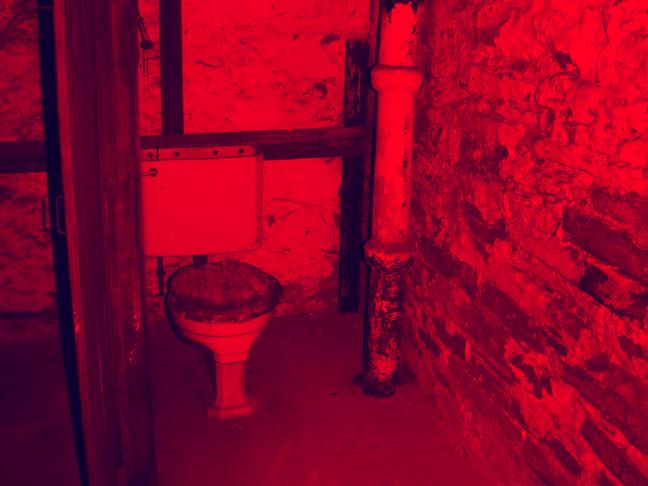Basement toilets are a pervasive feature of Pittsburgh homes -- so much so that one local photographer set out to document them.
And although local lore suggests they were first installed so that mill workers and miners could clean up before entering the main part of the house, multiple local experts said they couldn't verify that, and most declined to weigh in on how these mysterious home features came to be.
Now, one architect is providing some answers. 90.5 WESA’s Sarah Kovash spoke to architect William Martin, who studied at Carnegie Mellon University and graduated from the Pratt Institute. The New Jersey resident is also chairman of the Historic Preservation Committee at the Pascack Historical Society. Martin said they weren’t designed for steel workers; in fact, they weren't even meant to be used.
Their conversation has been edited for length and clarity.
SARAH KOVASH:These toilets are usually found in pre-World War II-era homes. Can you give me a little background as to what plumbing was like then?
WILLIAM MARTIN:Well, they go from just before World War II to back to about the 1880s, depending on where you are in the country and depending on whether or not your city had sewers in the streets or not. So, about the mid-1800s is when cities realized that in order to develop and have density of population to protect their populations they needed to have underground sewers in order to deal with all of the trappings of a dense population.
The large cities, especially in the Northeast, began to put sewers into the streets. In some cases back then, they didn't have the piping we had, they would use trees and hollow out the trunk and it would use that as a sewer pipe because they needed the big size of the pipe to make it work.
KOVASH: How effective was that as a sewage pipe?

MARTIN: It worked very well for a long time. But as the population increased, and there's more and more of fluid flowing through the pipes, they began to have some issues. You know, you have clogs and things like that. And then of course as the technology advanced through you know closer to 1900 and in the early 1900s, you know, the early 20th Century, they had new materials for piping and things gradually got better in terms of the sewers and how they worked.
KOVASH: So, how did we eventually end up with toilets in our basements, then?
MARTIN: As the systems were used more and more, backups would occur. And when a sewer backed up, it would back up and it fills up the pipe like you're filling up a jar. Eventually you're going to reach the point where you fill up the jar and it starts to spill over. Well, in a home, what happens is the sewage backs up the pipe and into the fixtures that are connected to it. So, if you have your main living space on your first floor and you have your nice tiled beautiful bathroom and the sewer backs up on your street -- and you might not even be the cause of it -- the sewer backs up. It's going to come up through your bathtub, it's going to come up through your toilet and it's going to spill over and it's going to be all over your living space.
So the idea was to put a toilet fixture in the basement, and that's why they're by themselves, because they really weren't meant to be used. And they are at the lowest point of the system. So, as the sewer backs up, it will make itself known in the basement, because the toilet in the basement would overflow and into largely an unfinished basement, and then you would know to alert the city that there was a clog that they needed to clear it. And once the clog was cleared, you could then clean up the mess.
Now, when you were cleaning up the mess you were simply cleaning up your basement concrete slab, which was a relatively easy thing to do. This is also the reason why people did not finish their basements, because the sewer backups did occur from time to time.
KOVASH: If they weren’t meant to be used, why put a toilet down there? Why not just leave a drain or pipe?
MARTIN: The drain isn't big enough. It's a small aperture. The toilet is the largest fixture that's connected to the system. So if there’s going to be a backup, it will come out of the toilet in the basement. If you put it on a floor drain, what will happen is, as the sewer backs up it will continue to back up, fill up the plumbing once and you'll have the same problems upstairs. You need to give it the simplest way to get out and that's what they did.
KOVASH: Most people in Pittsburgh agree that these toilets, or Pittsburgh Potties as they’re sometimes referred to, were installed for miners and mill workers to use – especially when they came home from work so that they could clean up before going into the nice part of the house. Are you saying that’s not the case?
MARTIN: I’m not sure that some didn’t do that, but these are not unique to Pittsburgh.
KOVASH: So where else are these basement toilets found?
MARTIN: Well, they’re all around northern New Jersey, all around the suburbs of New York City. They exist in New England, up in the Boston area, Philadelphia, you know, all around the Northeast. I'm not sure about other parts of the country because I haven't encountered them in other parts of the country, but it wouldn't surprise me if you saw them in other cities, as well.
